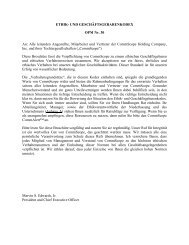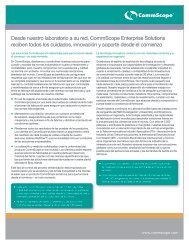Active Antennas: The Next Step in Radio and Antenna Evolution
Active Antennas: The Next Step in Radio and Antenna Evolution
Active Antennas: The Next Step in Radio and Antenna Evolution
Create successful ePaper yourself
Turn your PDF publications into a flip-book with our unique Google optimized e-Paper software.
BTS<br />
(Channel<br />
Cards,<br />
<strong>Radio</strong>s,<br />
Amplifiers,<br />
Filters)<br />
<strong>The</strong> Past<br />
Conventional<br />
Passive<br />
<strong><strong>Antenna</strong>s</strong><br />
RET Coax<br />
Jumpers<br />
Masthead<br />
Amplifiers<br />
Coax<br />
Cables<br />
Base<br />
Station<br />
Server<br />
Channel<br />
Cards<br />
WP-105435-EN (10/11) 4<br />
<strong>The</strong> Present<br />
Remote <strong>Radio</strong> Head<br />
RET<br />
Passive<br />
<strong><strong>Antenna</strong>s</strong><br />
Coaxial<br />
Cables<br />
Remote<br />
<strong>Radio</strong><br />
Head<br />
Figure 2: Cell site architecture evolution.<br />
Base<br />
Station<br />
Server<br />
<strong>The</strong> Future<br />
<strong>Active</strong> <strong><strong>Antenna</strong>s</strong><br />
<strong>The</strong> next stage <strong>in</strong> the evolution of the site architecture is the actual <strong>in</strong>tegration of the radio <strong>in</strong>to the<br />
antenna <strong>and</strong> the distribution of the radio functionality across the antenna elements. This is an active<br />
antenna.<br />
Channel<br />
Cards

















